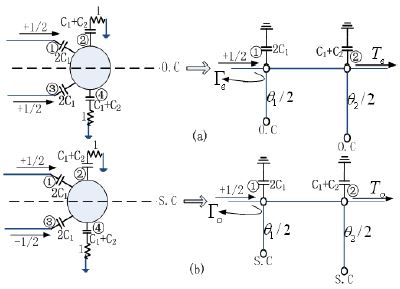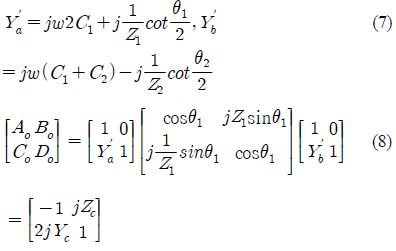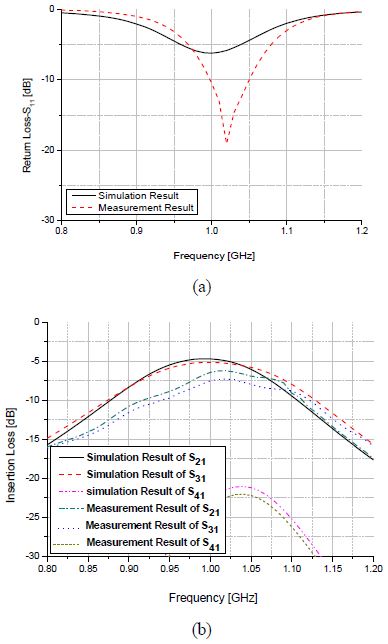
Design of an extremely miniaturized planar ring hybrid
This paper presents a method for analyzing and designing an extremely miniaturized planar ring hybrid, using the combination of parallel and diagonally shorted coupled lines. In contrast to conventional miniaturized coupled line filters, it is proven that the required electrical length of transmission line can be largely reduced to even a few degrees, not only effectively suppressing the spurious passband but also approximately maintaining the same characteristic around the stable center frequency. A ring hybrid filter at center frequency of 1 GHz was fabricated on the FR4 epoxy glass cloth copper-clad plat (CCL) PCB substrate. The insertion loss of a ring hybrid filter with the die area of 30 mm × 30 mm is -4.68 dB. Simulated results are well agreed with the measurements.
Keywords:
stable center frequency, ring hybrid, coplanar coupled line, electrical length1. Introduction
Ring hybrids are key components in many wireless and mobile communications as well as microwave, millimeter-wave circuits. The elementary line of the ring hybrid is a quarter transmission line that results in the large area and high cost for realizing in the circuit. To reduce the area of ring hybrid, Several approach were reported. One efficient method is to deploy the slotted ground which gives rise to slow wave effect in the printed circuit [1]. By connecting multiple open stubs on the inside of the ring, reduced ring hybrid is achieved [2]. Parallel coupled lines are applied to design a microstrip ring hybrids for size reduction [3]. However, these approaches for the miniaturization in the ring hybrid was limited in the size reduction. Therefore, major challenge for the miniaturization of ring hybrid is still remain.
In this paper, an extremely miniaturized ring hybrid filter using diagonally shorted coupled lines as well as parallel end-shorted coupled lines with lumped capacitors is introduced. As a new size-reduction method for λ/4 or 3λ/4 transmission line, the size of the ring hybrid can be controlled arbitrarily in theory and reduced to just a few degrees without sacrificing the characteristics of the conventional ring hybrid filter at the operating frequency.
2. An extremely miniaturized ring hybrid
2.1 Conventional ring hybrid
A conventional ring hybrid has been shown in Figure 1, consisting of three quarter-wavelength transmission lines and one line with a length of 3λ/4, at a center frequency. Generally, characteristic impedances of the ports and ring are 50Ω and 70.7Ω, respectively. Port1, 4 are usually used for the sum and difference ports.
2.2 Reduced size ring hybrid
In order to reduce the ring hybrid circuit, the quarter and 3λ/4 section line composing it need to be miniaturized. The quarter transmission line shown in Figure 2(a) is shortened into the capacitive-loaded line Figure 2(b), by size reduction method proposed by Hirota [4]. The parallel end shorted coupled line in Figure 2(c) can be replaced by lumped inductive series element with shunt resonant circuits in the both side in Figure 2(d).
The related formulas are expressed by [5]
When ωLAL = ZC and ωCA1 =1 / ZC , it could be a quarter transmission line. The electrical length θ1 need to decrease in Equation (1) for the miniaturization of quarter transmission line and the difference of ZAoe and ZAoo also decreases.
The diagonally end-shorted coupled line in Figure 2(e) is equal to the miniaturized capacitive load line with shunt resonant circuits in the both side in Figure 2(f) [6]. It can be relatively highly miniaturized comparing the capacitively loaded transmission line. This miniaturized coupled line is acted as 3λ/4 transmission line because diagonally end-shorted coupled line section includes a phase inverter [7]. Since resonant circuit in the equivalent coupled line in Figure 2(f) is open at a center frequency, the miniaturized coupled line in Figure 2(e) is the same as capacitive loaded circuit with phase inverter Figure 2 (b).

Quarter-wavelength transmission line(a), capacitively loaded transmission line(b), parallel end shorted coupled line(c), reduced capacitive load line with shunt resonant circuits(d), diagonally end-shorted coupled line(e) and miniaturized capacitive load line with shunt resonant circuits(f).
The related equations are expressed by as follows:
where Z1,Z2 and Zc are the characteristic impedances of the shorted coupled lines and characteristic impedance of the quarter transmission line. θ1, θ2 and ω are the electrical lengths of the shorted line and angular frequency, respectively. CBl is lumped capacitor in the capacitively loaded circuit, CA0 and CB0 are the capacitors for the resonance with shunt inductor. C1 is the combination of CA0 and CAl and C2 is the combination of CB0 and CBl. Zoe and Z00 are the even and odd mode characteristic impedance of coupled line.

Even- and odd-mode decomposition of the ring hybrid when port 1 is excited with a unit amplitude incident wave. (a) Even mode. (b) Odd mode.
Figure 3(a) is a miniaturized ring hybrid employing the capacitively loaded circuit. It can be transformed into equivalent circuit made up the reduced coupled lines shown in Figure 3(b) Actually this circuit with coupled lines will be fabricated for the extremely miniaturized ring hybrid circuit.
Analysis of the reduced size hybrid ring can be performed using the symmetry of the component with respect to a line A – A1, as depicted in Figure 3(a) and the even-odd mode method. We can evaluate the required reflection and transmission coefficients defined using the ABCD matrix for the even- and odd-mode two-port circuits in Figure 4.
According to Figure 4(a), if two signals of amplitude 1/2 and in phase are applied at ports 1 and 3 (even-mode excitation), the magnetic wall is formed at A – A1. This is equivalent to an open circuit, as indicated in Figure 5.
In a similar way, according to Figure 4(b) if two signals of amplitude 1/2 and 180° out of phase (odd-mode excitation) are applied at ports 1 and 3, the electrical wall is created at A – A1. This is equivalent to an short circuit, as indicated in Figure 6.
The reflection and transmission coefficients for the even-and odd-mode of the ring hybrids are given by:
The amplitudes of the scattered waves from the ring hybrid will be:
Then with the aid of (9),(10),(11) and (12), according [8] we have:
The input port 1 should be matched, so we let B1= 0, then we can get
 , now the above results turn to be
, now the above results turn to be
Which shows that the input port is matched, port 4 is isolated, and the input power is evenly divided and in phase between ports 2 and 3.
Now consider a unit amplitude wave incident at port 4 (the difference port) of the ring hybrid of Figure 1. The two wave components on the ring will arrive in phase at ports 2 and 3, with a net phase difference of 180° between these ports. The two wave components will be 180°out of phase at port 1. This case can be decomposed into a superposition of the two simpler circuits and excitations shown in Figure 7.

Even- and odd-mode decomposition of the ring hybrid when port 4 is excited with a unit amplitude incident wave. (a) Even mode. (b) Odd mode.
Similarly, the ABCD matrices for the even- and odd-mode circuits of Figure 7 are
The amplitudes of the scattered waves from the ring hybrid will be:
Similarly, according to the above analysis, we can get
The input port 4 should be matched, so we let B ′4 = 0, then we can get
 , now the above results turn to be
, now the above results turn to be
Which shows that the input port is matched, port 1 is isolated, and the input power is evenly divided into ports 2 and 3 with a 180° phase difference.
3. Simulations and measurements
3.1 Simulation Results
Once the ring hybrid filter equivalent circuit model was built, physical filter structures such as resonators and coupled-line sections can be designed. However, one thing needs to be kept in mind that due to the parasitic components (both internally and externally) the synthesized filter model cannot be transformed into physical structures at one shot. As a result, some circuit tuning for the filter responses and optimizations of the filter physical dimensions need to be carried out. Generally, it is carried out with Ansoft HFSS before fabrication until the full-wave electromagnetic (EM) simulation shows a good performance close to the target one.
We designed the miniaturized ring hybrid circuit employing the coupled lines of 15 degrees for replacing quarter transmission line. Table 1 gives the design parameters of the HFSS simulation. Figure 8 (a) and (b) show simulated the insertion and return loss responses of the ring hybrid filters , respectively. The parameter values in the Table 1 were appropriately tuned for proper simulation results.
responses of the ring hybrid filters , respectively. The parameter values in the Table 1 were appropriately tuned for proper simulation results.
3.2 Measurement Results
The photograph in Figure 9 shows a fabricated ring hybrid with 4 ports, with total die area (including the capsulated ground plane) of 30 mm × 30 mm. It was manufactured on the FR4 epoxy glass cloth copper- clad plat (CCL) PCB substrate having thickness 0.8mm and dielectric constant εr=4.4. The measured performances of the fabricated at 1GHz ring hybrid is compared with HFSS simulation results in Figure 10 and Figure 11. It shows equal power splitting performance and good phase response. The insertion loss of simulation results by HFSS is -4.68dB and measurement result is –6.42dB. Additional loss in the measurement isconsidered to be caused by surface and edge roughness of the metal, inferior metal conductivity, the dielectric loss of the substrate and the inexactness of fabrication technology and so on, which were not taken into account in the calculations. The ring hybrid operating at 1 GHz exhibits a band width of 130MHz and 180o ± 6o degree phase difference.
Finally, Table 2 summarizes the characteristic of several published ring hybrid in comparison with this work. Obviously, the proposed in this paper shows the advantage of more compact size, excellent insertion loss characteristic.
4. Conclusion
Miniaturization method of ring hybrid filter using coupled line circuits has been proposed in the planar structure. The electrical length of the coupled lines in the ring hybrid could be reduced up to a few degrees and the size of ring hybrid shrunk about 35 times smaller than conventional one. The measurement responses agree well with simulation result curves. Ring hybrid can be easily fabricated that it makes this design suitable for microwave integrated circuit(MIC) and MMIC applications.
References
-
Y. J. A. Sung, C. S. Ahn, and Y.-S. Kim, “Size reduction and harmonic suppression of rat-race hybrid coupler using defected ground structure”, IEEE Microwave Wireless Components Letters, 14(1), p7-9, (2004).
[https://doi.org/10.1109/LMWC.2003.821499]

-
M. L. Chuang, “Miniaturized ring coupler of arbitrary reduced size”, IEEE Microwave Wireless Components Letters, 15(1), p16-18, (2005).
[https://doi.org/10.1109/LMWC.2004.840960]

-
H. S. Lee, and K. Choi, “A harmonic and size reduced ring hybrid using coupled lines”, IEEE Microwave Wireless Components Letters, 15(1), p16-18, (2005).
[https://doi.org/10.1109/LMWC.2007.892954]

-
T. Hirota, “Reduced-size branch-line and rat-race hybrids for uniplanar MMIC’s”, IEEE Transactions, Microwave Theory Techniques, 38(3), (1990).
[https://doi.org/10.1109/22.45344]

- I. Kang, and J. S. Park, “A reduced-size power divider using the coupled line equivalent to a lumped inductor”, Microwave Journal, 46(7), (2003).
- I. Kang, S. Shan, X. Wang, Y. Yun, J. Kim, and C. Park, “A Miniaturized GaAs MMIC filter for the 5GHz band”, Journal of Microwave, 50(11), p88-94, (2007).
-
S. P. Marsh, “A wide-band stripline hybrid ring”, IEEE Transactions, Microwave Theory Techniques, 16(6), p361, (1968).
[https://doi.org/10.1109/TMTT.1968.1126693]

- D. M. POZRA, Microwave Engineering, Wiley, New York, (1998).
-
Tze-Min Shen, Chin-Ren Chen, Ting-Yi Huang, and Ruey-Beei Wu, “Design of lumped rat-race coupler in multilayer LTCC”, Asia Pacific Microwave Conference, p2120-2123, (2009).
[https://doi.org/10.1109/APMC.2009.5385258]























